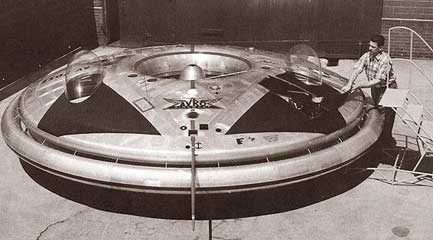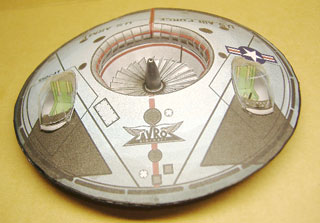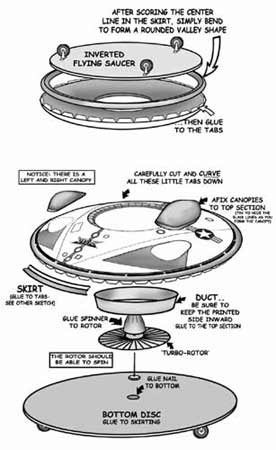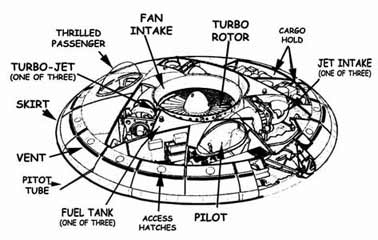


Flying Saucer - $$5.95
At the time, Frost was particularly interested in jet engine design and ways to improve the efficiency of the compressor without sacrificing the simplicity of the turbine engine. This led him to design a new type of engine layout with the flame cans lying directly outside the outer rim of the centrifugal compressor.
Avro Avrocar Flying Saucer
The U.S. Army became interested in the project in 1958, feeling that the circular wing could fit in with its plans for a "flying jeep", the Air Force agreed to redirect its effort as this could demonstrate the design features of the 606A concept in less time at a much lower price.
The resulting craft was named Avrocar and given the Army designation VZ-9AV (VZ for vertical take-off research aircraft, (as it was the ninth in a series and AV for Avro)
I just love the Avrocar! Its a must-have for any Canadian Aviation fan. And it gives us all hope that a CF100 and 105 might someday pop up too .......Tim.
She sho is purdy!!!! Ohhhhhhh...TW
Great work Sparky! Love to see it on silver paper...Bonz
Way cool Sparky! Ya know, this could be another of those FG models that really fly well (Just a flip of the wrist ....).T.
Cool, at last an aircraft from north of the 49th parallel. Now I beg you on bended knees for the CF-105 and the CF-105 Regards, Rick Thomson
Avrocar "Flying Saucer"
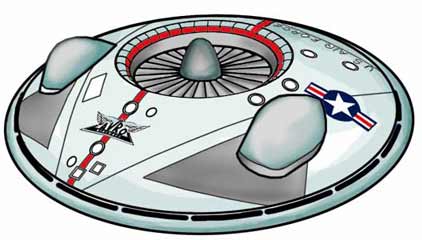
1952, Avro Canada began to study designs for a supersonic circular wing fighter-bomber, this was funded by the Canadian government with $400,000 allocated. After the $400,000 ran out the Canadian government abandoned the project as being too costly, however enough progress had been made to spark the interest of the U.S. governement.In July 1954, the first of two U.S. Air Force contracts totaling $1.9 million was awarded to Avro for further study, Avro chipped in $2.5 million and completed design studies and small scale test on a vehicle designated the P.V. 704 (U.S. designation, System 606A).
The 606A design was almost 30 ft. in diameter with a maximum weight of 27,000 lbs and a design speed over 1,000 mph.The U.S. Army became interested in the project in 1958, feeling that the circular wing could fit in with its plans for a "flying jeep", the Air Force agreed to redirect its effort as this could demonstrate the design features of the 606A concept in less time at a must lower price.The resulting craft was named Avrocar and given the Army designation VZ-9AV (VZ for vertical take-off research aircraft, 9 as it was the ninth in a series and AV for Avro)
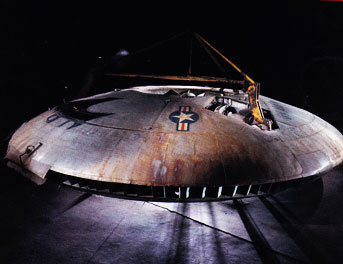 |
| The Avrocar (Flying Saucer) is in the Paul E. Garber Preservation, Restoration, and Storage Facility, and the facility is no longer open for public diplay. Another Avrocar is also on display at the Western Canada Aviation Museum in Winnipeg, Manitoba, Canada. Gerry Neufeld, Steinbach, Manitoba, Canada |
The Avrocar was a saucer-shaped disk 18 ft in diameter and 3 ft thick, it was designed to go 300 mph and able to fly to an altitude of 10,000 ft. It weighed 5,650 lbs and had separate cockpits for two crew members. Three Continental J-69 turbojet engines powered a centrally located fan with a diameter of 5 feet. Two prototypes rolled out of the factory in May and August of 1959 just months after the Arrow project had been cancelled.
The first Avrocar (58-7055) was sent to NASA Ames, Moffett Field in California it first flew there on 17 May 1961 and was used for wind-tunnel testing. The second Avrocar took first tethered flight on 29 September 1959 lasting 12 seconds. The first un tethered flight occurred on 12 November 1959. Formal Air Force flight evaluations occurred at Avro in April 1960 and June 1961 - tests showed that the maximum speed was 35 mph and research at NASA showed that the Avrocar was aerodynamically unstable.
The program was terminated in December 1961 after a total of $10 million had been spent. At Avro (U.K.) project 724 never proceeded beyond the designs stage in June 1953.
From Aircraft Magazine - October 1962:
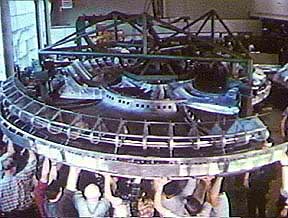 The prototype of the vehicle which at one stage gave the Canadian
aircraft industry good promise of a major breakthrough in VTOL
is today collecting dust in a hangar of the National Aeronautics
and Space Administration's Ames Research Center at Moffett Field,
Calif. Word from the Center's chief of flight and systems simulation
is that no further flight tests are
planned with the Avrocar, once regarded as the most advanced and
most promising project in the application of ground-effect to
development of a pure jet VTOL vehicle. The "Saucer"
is reported to have performed well within its ground-effect envelope,
but was unstable above about three feet. Initiated by Avro Aircraft,
the "Saucer" project was taken over by the U.S. government
after Canadian Government support was withdrawn in 1954. A post-mortem
on the Avrocar is offered by pilot Fred J. Drinkwater III, a research
engineer: "All the new flying concepts are cans of worms
at the early stage. Tests showed the saucer would have taken too
much more development effort. Other concepts proved more promising".
The prototype of the vehicle which at one stage gave the Canadian
aircraft industry good promise of a major breakthrough in VTOL
is today collecting dust in a hangar of the National Aeronautics
and Space Administration's Ames Research Center at Moffett Field,
Calif. Word from the Center's chief of flight and systems simulation
is that no further flight tests are
planned with the Avrocar, once regarded as the most advanced and
most promising project in the application of ground-effect to
development of a pure jet VTOL vehicle. The "Saucer"
is reported to have performed well within its ground-effect envelope,
but was unstable above about three feet. Initiated by Avro Aircraft,
the "Saucer" project was taken over by the U.S. government
after Canadian Government support was withdrawn in 1954. A post-mortem
on the Avrocar is offered by pilot Fred J. Drinkwater III, a research
engineer: "All the new flying concepts are cans of worms
at the early stage. Tests showed the saucer would have taken too
much more development effort. Other concepts proved more promising".
Canada's Flying Saucer
by Bill Zuk
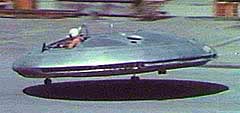 The Avro Canada VZ-9-AV "Avrocar" designed by company
Chief Designer John Frost was a true flying saucer that was produced
for the U.S.A.F. and U.S. Army in the period 1958-1959. The Avrocar
was built as a research vehicle with a pilot and observer in separate
cockpits on either side, facing front. It used three Continental
J-69's (licence-built Turbomeca Marboré) turbojets, turning
a central impeller ("turbo rotor") to keep it airborne
with downward thrust, with a vane/shutter system to propel the
craft in any direction by venting thrust in the direction the
pilot desired. The total diameter of the Avrocar was 6.2 m., with
wheels and later tricycle landing pads for an undercarriage.
The Avro Canada VZ-9-AV "Avrocar" designed by company
Chief Designer John Frost was a true flying saucer that was produced
for the U.S.A.F. and U.S. Army in the period 1958-1959. The Avrocar
was built as a research vehicle with a pilot and observer in separate
cockpits on either side, facing front. It used three Continental
J-69's (licence-built Turbomeca Marboré) turbojets, turning
a central impeller ("turbo rotor") to keep it airborne
with downward thrust, with a vane/shutter system to propel the
craft in any direction by venting thrust in the direction the
pilot desired. The total diameter of the Avrocar was 6.2 m., with
wheels and later tricycle landing pads for an undercarriage.
In earlier research, Frost had discovered the "Coanda Effect" provided a powerful ground cushion envisioned as being the basis for a vehicle that could have both have VTOL (vertical take-off and landing) capabilities and could still operate as a high-performance aircraft. Avro Canada and the Canadian government provided the initial funding for Frost's work. He continued to lobby for the project now called the Project Y-2 and achieved a remarkable breakthrough by demonstrating the project to the United States Air Force. With funding from the both the U.S.A.F. and later the U.S. Army, Frost proceeded with his design. From 1955 to 1959, the design team concentrated on the new VZ-9AV "Avrocar" as a "proof of concept" vehicle for a concurrent supersonic fighter development program.
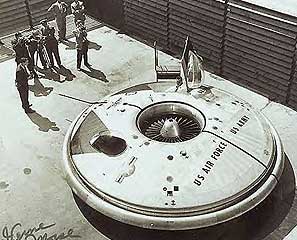 Two Avrocar prototypes were constructed and completed a series
of wind tunnel tests and a flying program both at NASA Ames in
California and at the Malton home of Avro Canada. The results
of the testing revealed a stability problem and degraded performance
due to turbo-rotor tolerances. Before modifications could be achieved,
funding ran out with the final flight test program completed in
March 1961. With the problems that the contractor was facing in
the wake of the cancellation of its premier fighter program, the
Avro Arrow by the Canadian government, Avro was unable to continue
the project. The Avrocar had been the last aviation
program of Avro Canada. The parent company. A. V. Roe Canada which
had been in throes of disintegration for years ceased to exist
on April 30, 1962.
Two Avrocar prototypes were constructed and completed a series
of wind tunnel tests and a flying program both at NASA Ames in
California and at the Malton home of Avro Canada. The results
of the testing revealed a stability problem and degraded performance
due to turbo-rotor tolerances. Before modifications could be achieved,
funding ran out with the final flight test program completed in
March 1961. With the problems that the contractor was facing in
the wake of the cancellation of its premier fighter program, the
Avro Arrow by the Canadian government, Avro was unable to continue
the project. The Avrocar had been the last aviation
program of Avro Canada. The parent company. A. V. Roe Canada which
had been in throes of disintegration for years ceased to exist
on April 30, 1962.
Both Avrocar's are still intact, and survive in U.S. museums. The U.S. Army Transportation Museum at Fort Eustis, Virginia received the second Avrocar, the "flying" prototype, 59-4975 from the U.S. Army Aviation Materials Laboratories at Fort Eustis, Virginia in 1979. The first Avrocar, S/N #58-7055, the unmanned test rig and wind tunnel test vehicle marked as AV-7055 was never flown. It was shipped to the NASA Ames Research Center wind tunnel at Moffett Field, California in 1960. After wind tunnel testing, it remained for years in storage at the NASA facility before being donated to the National Air and Space Museum in 1966. Today AV-7055 is stored in Building 22 of the NASM Paul E. Garber Storage and Restoration Facility, in Silver Hills, Maryland.
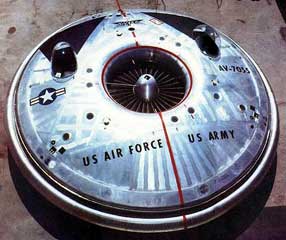
The unrestored Avrocar's or "flying saucers" as they are referred to at both the NASM and U.S. Army Transportation Museum are mainly neglected and relegated to objects of historical curiosity or oddity. It's time to bring Canada's "Flying Saucer" home! You have the opportunity to petition the Minister of Canadian Heritage, Government of Canada, to intercede with the United States government in bringing back a part of our nation's aviation history from the National Air and Space Museum in Washington, D.C. or the Army Transportation Museum at Fort Eustis, Virginia.
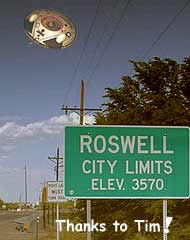
With the cancellation of the Avro Canada CF-105 Arrow program and the destruction of aircraft, films, photographs and other records of the company and final collapse of the company, Canadians lost a great part of our aviation industry and heritage. We have a sense that a wrong can still be made right. The National Aviation Museum has made an effort in recent years to bring back one of these abandoned aircraft to its original homeland. Today in Toronto, the work of hundreds of volunteers has resulted in the formation of the Toronto Aerospace Museum at the former Canadian Forces Base Downsview. This museum is dedicated to preserving and displaying the aerospace heritage of Toronto which includes the aircraft of the Curtiss, De Havilland Canada and Avro Canada companies that were once part of the city's aviation industry.
What a fitting tribute to bring back home to Canada, a monument to the men and women of A.V. Roe Canada whose final project was an aircraft of the future- our own "Flying Saucer" and have it on display in its former home- for all to see and wonder about what was once a dream that almost came to be. Forget the X-files! Did you know that the maker of the famous Avro Arrow also made Earth's first flying saucer? Between 1952 and 1962, a flying saucer project was developed by Avro Canada's Special Projects Group in Malton, Ontario. Author Bill Zuk is Canada's resident Avrocar "saucer" expert and leads the battle to "Bring Canada's Flying Saucer Home." (Two survive in U.S. museums.) Travel back in time to the paranoid days of the Cold War, when fear of invasion by Communists and aliens from other planets seemed almost equally plausible. This wonderful book shows flying saucers in various stages of production and in actual test flights. U.S. military illustrations show the saucers' potential use in combat. Fascinating stuff for Arrowheads, aviation enthusiasts, the sci-fi crowd and anyone who appreciates the strange-but-true.
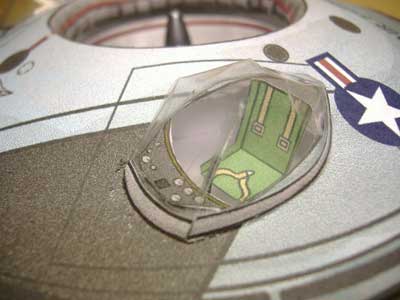 |
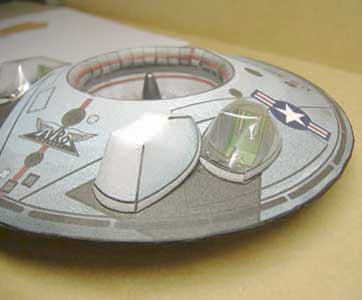 |
| These images of the Clear Cabin Avrocar were submitted by Bob Martin he says "After I built this one I thought I'd try clear canopies. I think I tried 3 or 4 times. So I thought I'd post it to show that not all canopies can be made with clear tape. Well after comparing them with the regular canopy, suprisingly they were very much the same. Altho, from up close you can see the tape tabs, I still think I like the clear ones better." Thanks so much Bob! | |
Specifications
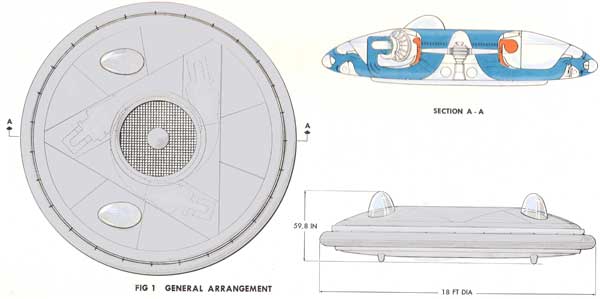 |
Crew: 2 Capacity: 1 observer/engineer Length: 18 ft Height: 3 ft 6 in Wing area: 254 sq ft Empty weight: 3,000 lb Max takeoff weight: 5,560 lb Powerplant: 3 × Teledyne CAE J69-T-9 , 660 lbf (2.9 kN) thrust each Performance Maximum speed: 300 mph (estimated), 35 mph (actual) Range: 995 mi (estimated), 79 mi (actual) Service ceiling: 10,000 ft (estimated), 3 ft (0.91 m) (actual) |
